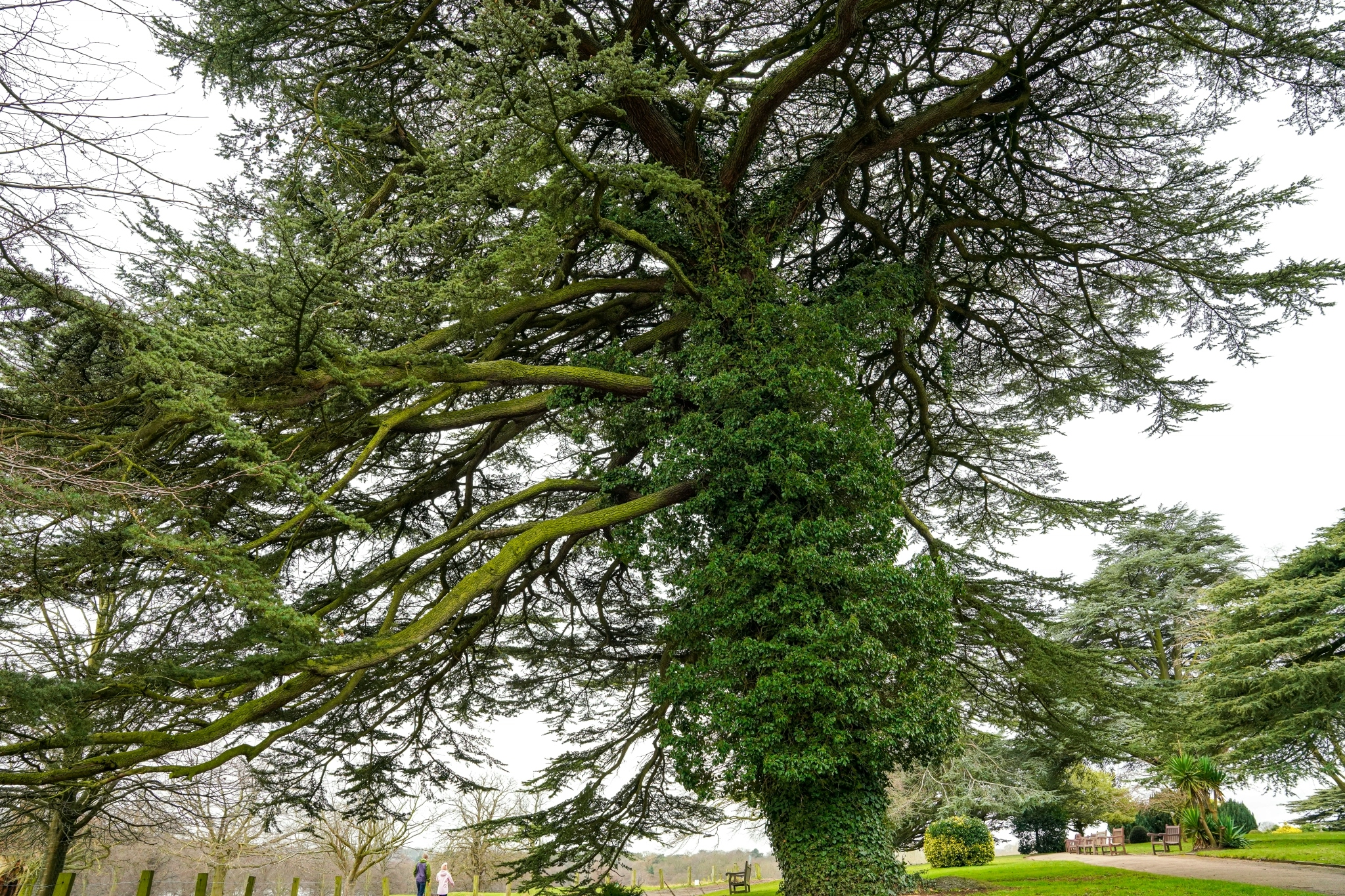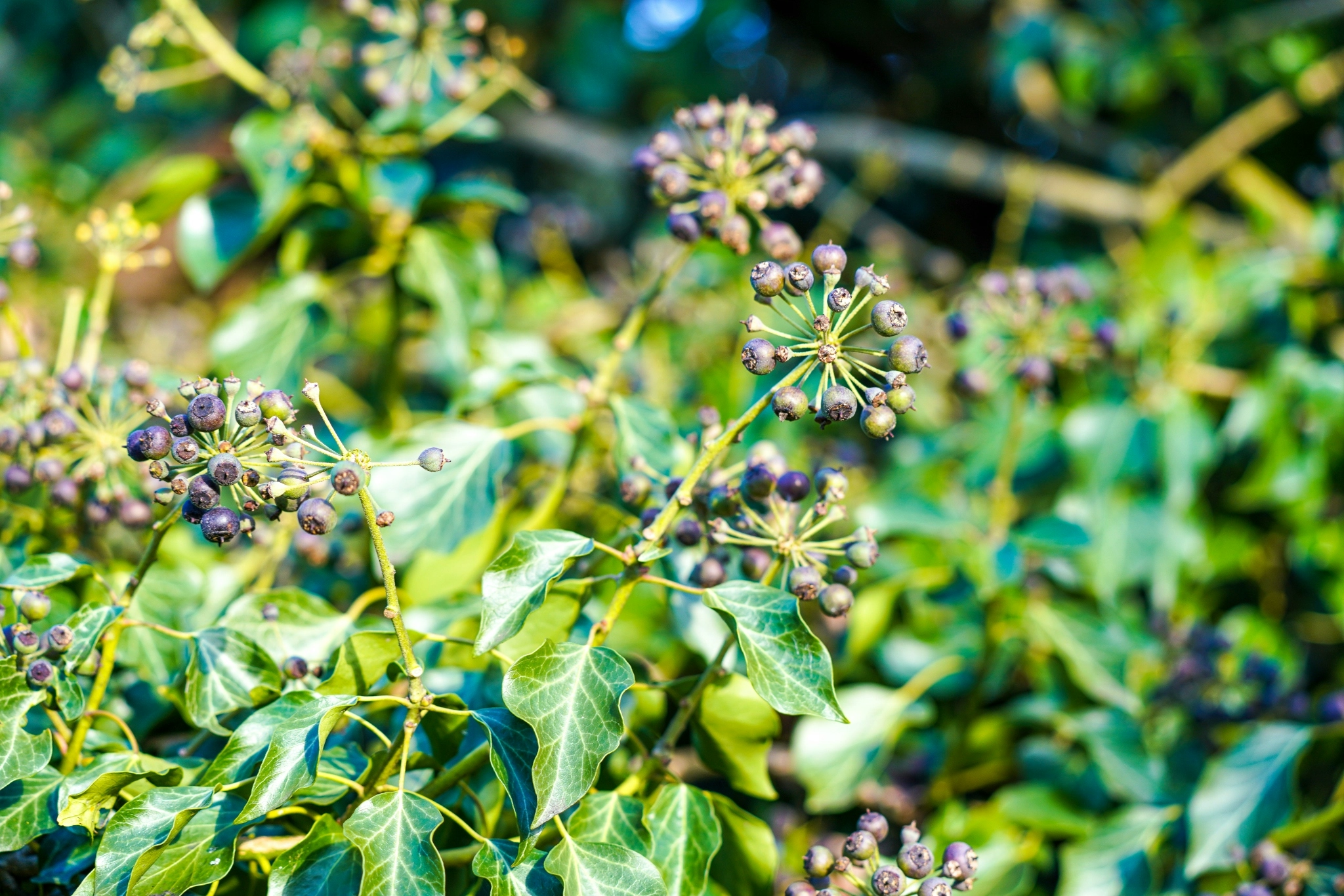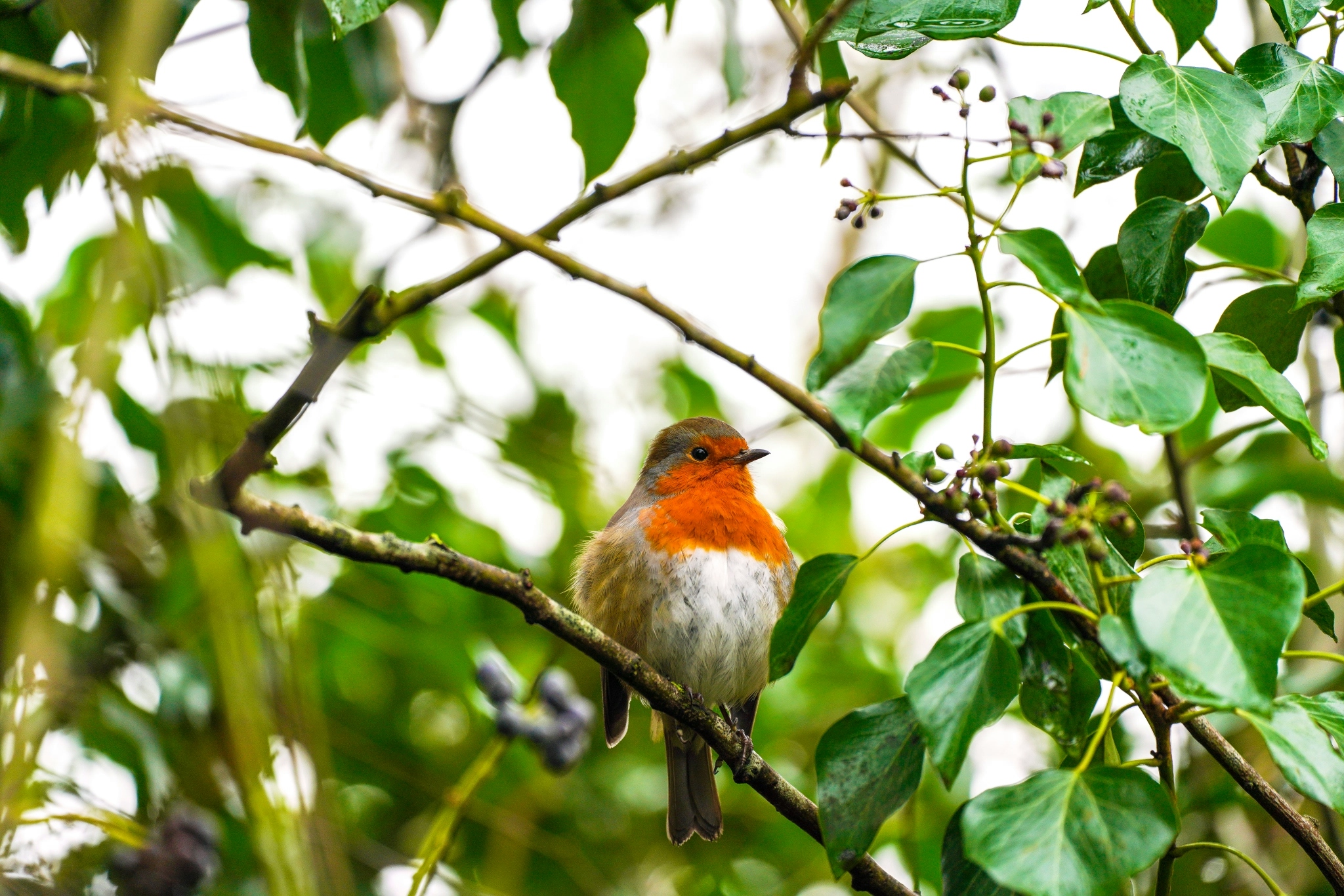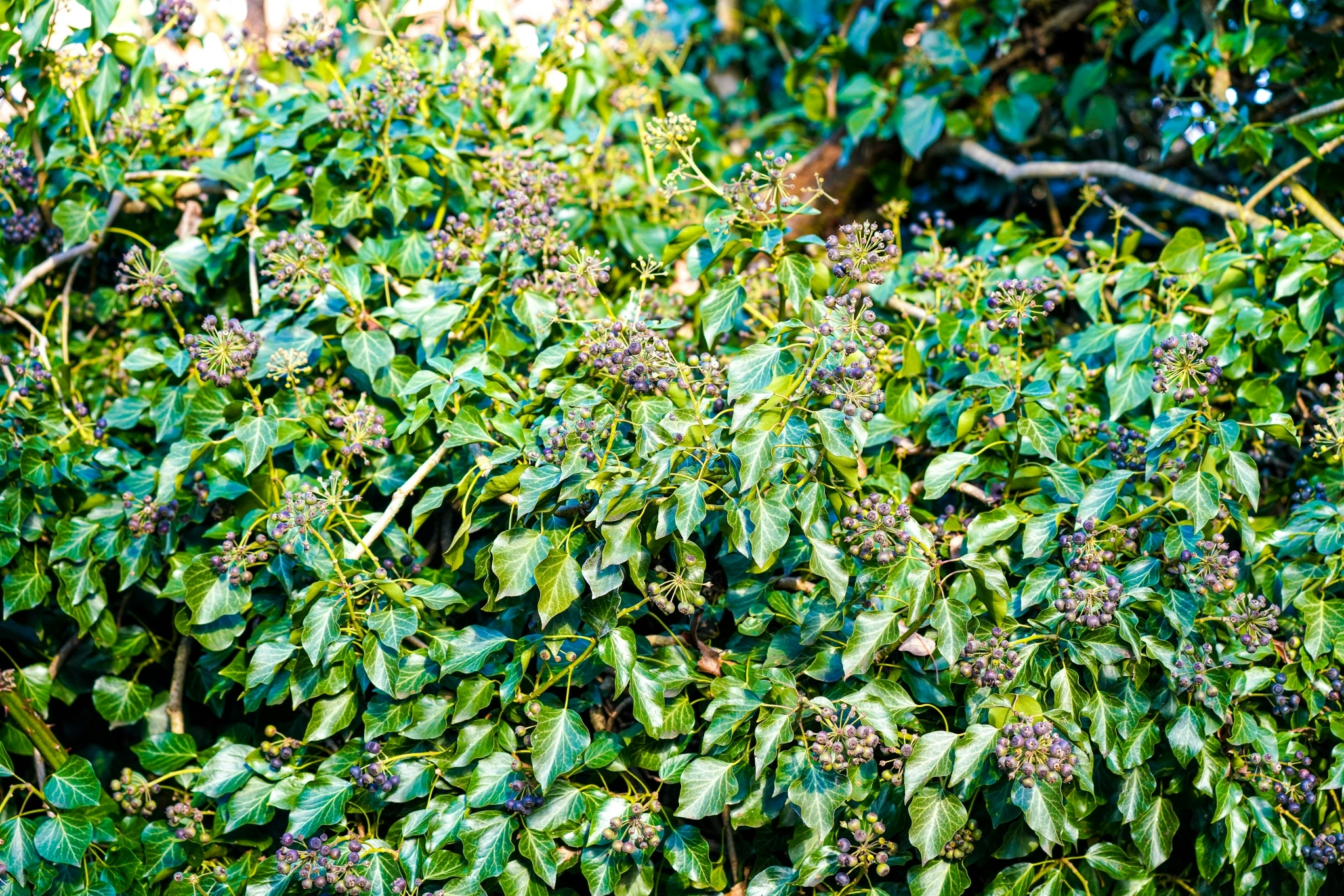WHY YOU SHOULD LOVE IVY

I recently noticed that the tall, beautiful, ivy-covered tree trunks in the grounds of my local university, that I had been driving past and admiring for years, were looking distinctly…naked. By about the fifth time of driving past them, I realised that someone had cut (or poisoned) the ivy at the base of the tree trunks so that it all died off.
Gardeners have been fighting with ivy for a long time, and it really is an example of a battle that doesn’t need to be fought, so here’s the run-down on what ivy is, what benefits it brings, and whether it causes any harm.
WHAT DOES IVY LOOK LIKE?
Young ivy has leaves with five points – they look like spiky hearts and if you were asked to draw ivy, this is probably what you’d draw. Mature ivy (older than about 10 years), has leaves like those in the photos of this article – more rounded and less like the plastic ivy plants people buy from Ikea. It grows up trees, on walls, and across the ground. It often looks more like a shrub or bush than a creeper.
In Autumn, mature ivy has clusters of little yellow flowers. In winter, these turn into dark fruits that look like berries. It’s evergreen, so it keeps its lush green leaves all year round.
Here's some mature ivy fruit in February:

WHY SHOULD I LOVE IVY?
You should love ivy because it:
Looks great all year round
Hosts nesting birds, including sparrows, robins and blackbirds
Provides cover for birds and small mammals (including bats)
Has autumn flowers that provide food for insects at a time when there’s not much around
Provides winter berries that feed birds when there’s even less food around (they’re super high energy too – they contain nearly as many calories as Mars Bars, gram for gram)
Protects walls and buildings
Absorbs pollution
Grows up walls, so if you have outdoor space but not much ground space you can create a ‘green wall’, providing a beautiful feature and important habitat that is low maintenance

DOES IT HARM TREES?
In most cases, no. Ivy is not a parasite – it doesn’t take any nutrients from the tree that it grows up. It has its own roots in the ground; it only uses the tree for support to grow high enough to reach more sunlight.
Ivy also doesn’t strangle trees or prohibit their growth. In fact, it rarely poses any threat at all to trees.
Occasionally, a tree covered in ivy will fall down – but this is usually because the tree was diseased or damaged independently form the presence of the ivy.
DOES IT RUIN WALLS AND BUILDINGS?
Again, in most cases, no.
English Heritage and Oxford University produced a fascinating report in 2010 called Ivy on Walls, based on three years’ research into the effect of ivy on various historically important buildings. They found that in almost all cases, ivy poses no threat to the integrity of a wall at all. In fact, ivy usually:
Protects the wall from the risks associated with freeze-thaw (which can cause degeneration)
Regulates heating and cooling, reducing the negative effects of cycling temperature
Reduces the effects of salt weathering on the wall
Regulates humidity and prevents rainfall hitting the wall, reducing chemical weathering
Absorbs pollutants that would otherwise damage the wall (and our lungs) – particularly for walls next to busy roads
Very occasionally, ivy will root in a wall if the wall already has imperfections in it. Whilst such rooting can cause damage, the research shows that in the vast majority of cases the benefits of ivy to the structure of a wall outweigh the risks.
IF IVY ISN’T A PROBLEM, WHY DO WE WAGE WAR ON IT?
“TIDINESS”
Part of the English Heritage study involved Ramsey churchyard which, because of the design of its gravestones, was home to a collection of unique ivy-covered gravestones. Honestly, these gravestones looked like Cousin It from the Addams Family. I strongly recommend reading that section of the report, if only for the photos.
The local residents were up in arms about the audacity of this plant growing in their churchyard and wanted to remove all of the ivy from the gravestones. The council were less keen on obliterating this natural phenomenon and called in the research team to see whether the ivy was harming the gravestones.
The team removed the ivy from a few different sample gravestones, and found that the ivy had not damaged the gravestones at all. Ultimately, the report concludes that the gravestones would deteriorate faster when left to the elements than while they are protected by the ivy.
The research team relayed these reassuring results to the council, but when they returned a year later the community had completely removed the ivy from all of the gravestones. Clearly aesthetics is personal choice (look at the photos following the link at the end of this article to decide for yourself) but to me the churchyard was robbed of a beautiful, unusual feature. The birds that nested in the ivy on the gravestones had to relocate, and the vital food source of flowers and berries was removed.
This was about the local Rotary Club wanting all the ivy in the churchyard to be cleared – not about an individual family wanting to keep their loved one’s gravestone clear through personal choice – so I strongly suspect it’s an example of ‘Ecological Tidiness Disorder’, (our obsession with over-tidying of nature) something Benedict Macdonald has identified as a key contributor to our penchant for destroying any scrap of natural habitat we can get our hands on.
MISCONCEPTIONS
Some people wage war on ivy because they panic and think that it damages trees or walls – but as explained above, the research shows the exact opposite.
BACK TO MY NAKED TREES: REMOVING IVY
Hopefully, if you’re lucky enough to be in the position of controlling a piece of land that has ivy on, this article has convinced you to love it and not to wage war on it. However, if for some reason you do need to remove ivy (such as if it’s reaching into delicate areas like roof tiles or guttering), do not chop it off at the bottom and wait for it to die.
This sounds like an efficient idea – surely it will just die and drop off of its own accord? Sometimes it will, but before it dies it will make an extremely valiant effort to stay alive, and this means growing new, thicker roots and trying to push them anywhere it can.
Ivy is nice when it’s allowed to use the roots it has in the soil, because it has no reason to go poking big disruptive roots into trees or buildings. If you cut off its soil roots, though, it has to try and find water from somewhere. The English Heritage study showed conclusively that cutting off the soil roots led to ivy causing much more damage than it ever would have caused in the first place.
The study also found that using poison to kill the ivy isn’t a good idea – it makes a right mess of the building you’re trying to take it off, and leaves behind a lot of material stuck to the wall that you then have to scrape off with tools, risking damage to the wall. Plus it poisons the ecosystem.
The answer in the unlikely event that you need to remove ivy is to cut it back by hand – it’s usually easy to peel back (this is because it doesn’t put proper roots into the wall and doesn’t cling too hard – hence why it’s not usually a problem!). Remember that because birds nest in ivy, you should remove or prune it outside of bird breeding season, which runs March-August inclusive.
It’s worth noting that in the study, when the team were asked to remove ivy from an historic building because it was perceived to be causing damage to the wall, they peeled it back (with little effort) to reveal a perfectly preserved and undamaged wall beneath. Panic over.
I don’t know what actually happened with the trees I drive past – it certainly looks like the soil roots to the ivy were cut or poisoned. It’s unlikely that the number of trees treated this way were diseased (and therefore that the ivy posed a risk to them), but I don’t have the details. I just hope that more people will read articles like this one and come to realise that ivy usually doesn’t need to be removed – and should be celebrated!

Resources
Ivy on Walls (2010) report by English Heritage and Oxford University: https://www.geog.ox.ac.uk/research/landscape/rubble/ivy/ivy-report.pdf
On the calorie value of ivy berries: https://www.rspb.org.uk/birds-and-wildlife/natures-home-magazine/birds-and-wildlife-articles/features/birds-and-berries/
On the value of having a ‘green wall’: Chiquet, C., Dover, J.W. & Mitchell, P. Birds and the urban environment: the value of green walls. Urban Ecosyst 16, 453–462 (2013). https://doi.org/10.1007/s11252-012-0277-9
Share with your friends
Subscribe to learn more
Join me in exploring our natural world and cultural heritage as we learn how to protect and restore it. Get notified on my latest posts and a monthly newsletter on wider conversation topics for us to chat about.
Recent Posts
If you enjoyed this one, then you might like these too.